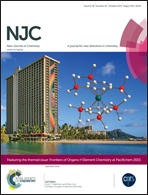Structural modeling, in vitro antiproliferative activity, and the effect of substituents on the DNA fastening and scission actions of heteroleptic copper(ii) complexes with terpyridines and naproxen†
Abstract
A series of heteroleptic copper(II) complexes of the type [Cu(L1–6)(nap)Cl] (1–6) (L1–6 = 4′-(4-substituted)-2,2′:6′,2′′-terpyridines, nap = naproxen) has been synthesized and characterized. The single crystal analyses of complexes 1 and 6 show distorted octahedral geometry around the copper(II) ion. Structural parameters from the crystallographic and DFT studies are in good agreement with each other. HOMO–LUMO energy levels are constructed and the corresponding theoretical frontier energy gaps are calculated to understand the charge transfer occurring in the molecule, and the lowering of the HOMO–LUMO band gap supports the bioactive properties of the molecule. Electrochemical studies show a one-electron irreversible reduction process in the cathodic potential (Epc) region from −0.75 to −0.82 V. The obtained room-temperature magnetic moment values (1.82–1.93 BM), XRD and EPR spectral data support a distorted octahedral geometry for the copper(II) complexes. The binding studies of complexes 1, 5 and 6 with CT-DNA imply a groove mode of binding, and complex 5 exhibits a higher binding affinity than the other complexes. The binding results are further supported by molecular docking studies. The higher binding propensity of complex 5, containing R5, was proved by computationally derived factors such as chemical potential (μ), chemical hardness (η), electrophilicity (ω) and nuclease-independent chemical shift (NICS). All the complexes display pronounced nuclease activity against supercoiled pBR322 DNA. The in vitro antiproliferative activity of complexes 1, 5 and 6 against human breast cancer cells (MCF-7) was assessed by MTT assay, which shows the potency of 1 and 5, with lower IC50 values than cisplatin and values comparable to doxorubicin. The complexes induce mitochondrial-mediated and caspase-dependent apoptosis with an increase in G0–G1 and subsequent arrest in the S phase in cell cycle evaluation.


 Please wait while we load your content...
Please wait while we load your content...